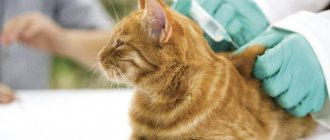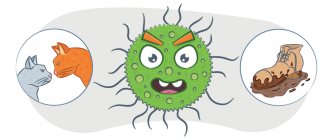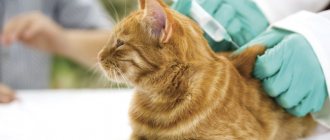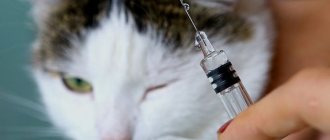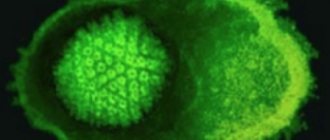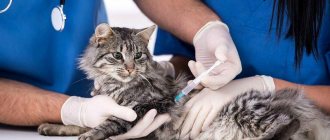Vaccination is one of the most important procedures for caring for domestic cats. This preventive measure helps prevent the development of the most dangerous feline diseases, leading to severe health consequences and premature death. Vaccinations for cats are done in veterinary clinics according to the vaccination calendar. The owner needs to properly prepare the animal for the procedure and follow all the doctor’s recommendations regarding caring for the cat after vaccination.
In the article we will look at why cats need vaccinations, how to prepare the animal for the procedure, recommendations for vaccinating cats depending on age, and types of medications.
Why is cat vaccination necessary?
Vaccination of cats is an effective measure to prevent a number of diseases, aimed at stimulating the production of antibodies that destroy active viruses that enter the animal’s body in case of infection. Simply put, vaccinations develop immune protection against various infections that provoke the development of deadly diseases.
In veterinary clinics, domestic cats are vaccinated at the request of the owner himself, who wants to protect his pet from the risks of contracting infections.
Vaccinations are recommended for all domestic cats without exception, even those who do not go outside at all. Viruses can spread through food and water. Even the most caring owner can become the culprit of a cat infection, bringing a dangerous infection into the house on clothes or the soles of shoes.
What diseases are vaccinated against?
According to the vaccination calendar, cats are recommended to be vaccinated according to age against several of the most dangerous diseases.
What diseases is it recommended to vaccinate your cat against?
- Rabies (rabies) is a deadly infectious disease that cannot be cured. Manifests itself with severe symptoms that occur 2-3 days after infection. Infected animals and rodents are carriers of the infection.
- Rhinotracheitis is a herpesvirus infectious disease that affects the respiratory and visual organs. Has an acute course. The carriers of the virus are sick cats. Mortality occurs in 20% of cases.
- Calcivirosis is a common infectious disease of cats, transmitted from other members of the genus who are carriers of the insidious virus. The risk of death is more than 80%.
- Viral peritonitis is an infectious disease caused by coronavirus. Infection occurs through airborne droplets after contact with a carrier of the infection. The risk of death is very high (more than 90% of cats die).
- Panleukopenia is an acute viral disease also known as feline distemper. Sick or already ill cats serve as spreaders of infection. Difficult to treat. Causes critical symptoms. The risk of death is 90%.
- Chlamydia is a contagious feline disease of an infectious nature with a severe and long-term course. The main carriers of infection are birds and rodents. The disease affects the genitourinary, respiratory, visual and digestive systems. There are risks of infecting people.
- Microsporia is a skin disease also known as ringworm. Carriers of infection are sick animals. A cat with microsporia often infects its owner. The most popular drugs for vaccinating cats against various infections: Nobivak, Quadrikat, Multifel-4, Microderm, Leukotsel, Felovax-4, etc. The drug will be selected by the attending veterinarian.
Types of cat vaccines
The following vaccines are most often used to vaccinate kittens:
- Nobivac Forcat. A multicomponent vaccine that stimulates immunity in kittens to calicivirus, panleukopenia, rhinotoacheitis and chlamydia;
- Nobivac Tricat. Triple action vaccine against calicivirus infection, rhinotracheitis and panleukopenia. The first vaccination for kittens is given at the age of 8 weeks. Revaccination (repeat vaccination) should be carried out annually;
- Nobivac Tricat. It also protects the little furry from the four main diseases listed. The first vaccination for a kitten can be given at the age of 12 weeks;
- Nobivac Rabies. This type of kitten vaccine only protects against rabies. The animal develops stable immunity 21 days after vaccination. Revaccination should be carried out annually. It is acceptable to mix Nobivak Rabies with other types of Nobivak vaccines;
- FORT DODGE FEL-O-VAX IV. This is a polyvalent vaccine - against several infections. Is inactivated. Protects the cat immediately from rhinotracheitis, panleukopenia, calicivirus and chlamydia. Approved for use in kittens over 8 weeks of age. Revaccination is carried out once a year;
- Purevax RCP. A multicomponent vaccine, which included strains of rhinotracheitis, panleukopenia and calicivirosis.
- Purevax RCPCh. Contains weakened strains of the viruses listed above. The vaccine is given at the age of 8 weeks. A month later they repeat. In the future, revaccination is indicated once a year.
- Leucorifelin. Protects the animal from viral viruses and panleukopenia. It is prohibited to administer Leucorifelin with other vaccines;
- Quadricate. Vaccination for kittens against panleukopenia, rabies and calicivirus. The kitten's immunity is formed in 2-3 weeks. Repeated vaccination is carried out every year;
- Rabizin. This drug is only for rabies. Unlike other types of vaccines, Rabizin can be administered even to pregnant cats;
- Leukocel 2. Vaccine against leukemia in cats. The vaccine is given twice. Then revaccination is carried out once a year. Kittens are vaccinated at the age of 9 weeks;
- Phelocel CVR. The drug stimulates the production of immunity against rhinotracheitis, panleukopenia and calicivirus. The vaccine looks like a porous mass of pale yellow color. Before use, it is diluted with a special solvent;
- Microderm. The vaccine allows you to protect the animal from dermatophytosis (lichen, etc.).
Important: it is worth remembering that young cats under 3 years of age, as well as old and weakened animals, are always at risk
Vaccination calendar for cats
Cats are vaccinated according to the preventive vaccination schedule according to age. Based on individual indications, the veterinarian can adjust the timing of immunization.
Vaccination schedule for cats:
- Panleukopenia, calcivirosis, chlamydia and rhinotracheitis - vaccination at 8 weeks, revaccination at 10-12 weeks and then after 12 months every year.
- Rabies - first vaccination at 12 weeks, revaccination annually.
- Microsporia - vaccination at 8 weeks, revaccination after 2 weeks and then every year.
- Viral peritonitis - first vaccination at 16 weeks, again after 4 weeks. Revaccination annually.
Vaccination rules
To ensure that the immunization procedure does not provoke side effects and complications, it is necessary to follow some rules for the safe vaccination of animals.
Basic rules of the preventive procedure:
- It is not recommended to vaccinate small kittens under 2 months of age.
- The vaccination is performed only by a veterinarian after examining the pet and studying its medical record.
- Vaccinations can only be given to healthy animals. The cat should be alert and active, have a good appetite and normal body temperature. If the examination reveals any symptoms of illness, vaccination is postponed for a certain period until complete recovery.
- To achieve high effectiveness, the cat must be vaccinated again after a certain time interval (re-vaccination).
- The drug to be administered to a pet should be chosen by an experienced veterinarian, based on personal experience and taking into account the individual health status of the cat.
- Before the immunization procedure, the animal must be properly prepared, following the doctor’s recommendations.
Are there any complications or side effects?
Only 0.5 - 1% of all animals vaccinated against common diseases annually are susceptible to complications or side effects. And the correct use of drugs, the high qualifications of the supervising doctor and the attentiveness of the owner when preparing the animal for the procedure can reduce the likelihood of adverse events to zero.
For the sake of health, you can be patient
But even if the probability is low, it is worth preparing for the possible consequences in advance. Here is a list of common complications from vaccination:
Allergic reaction
Symptoms of an injection allergy appear in the first 10 to 15 minutes after injection. Characteristic signs include increased salivation, difficulty breathing, or involuntary bowel movements. As a rule, veterinarians do not advise leaving the clinic for half an hour after an injection, so that the cat can be examined in a timely manner in case of any alarming symptoms and adequate antihistamines can be prescribed.
The appearance of a lump or redness at the injection site
Such a reaction is not dangerous; the swelling usually resolves within a couple of hours. If this does not happen or an abscess forms, urgent consultation with a doctor is necessary.
Incubation
Vaccinating an already sick animal that has not yet passed the incubation period can lead to the rapid development of the disease. Quarantine, as well as a full examination by a veterinarian before vaccination, will help you avoid problems.
In addition to the manifestations listed above, a reaction to an injection can be expressed through lethargy or hyperactivity, a temporary decrease in appetite, refusal to eat for several days, a short-term increase in body temperature and a feverish state.
What to do after vaccination
For 10 days after vaccination, you should quarantine, that is, exclude the cat from walking outside and any contact with animals. The pet should be protected from stress and hypothermia should be avoided. Particular attention should be paid to the proper nutrition of the cat. The diet should be balanced and complete.
If a cat experiences side effects after vaccination, it should be shown to a veterinarian. The doctor will conduct an examination, determine the cause of the symptoms, select a treatment course and decide on a further vaccination schedule. It may be necessary to revaccinate with a different vaccine.
How is rabies transmitted?
Carriers of rabies can be wild animals (foxes, wolves) or stray animals (cats, dogs). But even a pet is susceptible to infection. This can happen while walking. If a cat has a conflict with an infected animal, and during the fight the pet is bitten and scratched, then the risk of contracting rabies increases.
An animal that is constantly in an apartment can become infected with rabies from rats or mice. When eating rodents, the danger is a virus that is located in their brain. The likelihood of catching the disease from foreign objects that have been in contact with sick animals is low, because... The rabies virus quickly dies under the influence of sunlight, chlorine, and high temperatures.
Will not help destroy the virus:
In the brain of an animal that has died of rabies, the virus can persist for up to 3 months. It poses a danger in the cold season. Therefore, in winter, it is necessary to prohibit the cat from contacting foreign objects on the street.
To prevent the disease, animals are vaccinated, and care must be taken to ensure that the cat’s behavior remains normal after vaccination. If the cat is lethargic and inactive for more than a day, you need to show it to the veterinarian.
Vaccinations for cats: pros and cons
Before deciding to vaccinate a domestic cat, the owner can weigh the pros and cons of this procedure.
Benefits of animal immunization:
- The risk of contracting dangerous infections is reduced.
- The immune system is strengthened.
- The risk of infection to people from a sick cat is eliminated.
- After vaccination, the owner does not have to worry about the health of his children and the cat, which often walks outside.
- If the animal does become infected, the disease will be milder and will not cause complications or death.
The disadvantages of vaccinating cats are minor. These include the risks of side effects and complications after vaccination. As a rule, such consequences of animal immunization occur in very rare cases. If you follow all the doctor’s recommendations and select a high-quality vaccine to administer, you can be confident that the preventive procedure is safe for your cat.
